Synergistic Use of UAV and USV Data and Petrographic Analyses for the Investigation of Beachrock Formations: A Case Study from Syros Island, Aegean Sea, Greece
Abstract
:1. Introduction
2. Geological Setting
3. Survey Design
4. UAV and USV Data Collection and Processing, Field Sampling
4.1. UAV Data Processing
4.2. USV Data Collection and Processing
5. GNSS Measurements
6. Mineralogical and Petrographic Analyses
6.1. Analytical Methods
6.2. Mineralogical Analyses and Microstructures
6.2.1. XRD Analysis
6.2.2. Petrographic Features under Petrographic Polarizing Microscope and SEM Analysis
7. Discussion and Conclusions
Supplementary Materials
Author Contributions
Funding
Acknowledgments
Conflicts of Interest
References
- Mauz, B.; Vacchi, M.; Green, A.; Hoffmann, G.; Cooper, A. Beachrock: A tool for reconstructing relative sea level in the far-field. Mar. Geol. 2015, 362, 1–16. [Google Scholar] [CrossRef]
- Alexandersson, T. Recent littoral and sublittoral high-Mg calcite lithification in the Mediterranean. Sedimentology 1969, 12, 47–61. [Google Scholar] [CrossRef]
- Moore, C.H. Intertidal carbonate cementation Grand Cayman, West Indies. J. Sediment. Res. 1973, 43, 591–602. [Google Scholar]
- McCutcheon, J.; Nothdurft, L.D.; Webb, G.E.; Paterson, D.; Southam, G. Beachrock formation via microbial dissolution and re-precipitation of carbonate minerals. Mar. Geol. 2016, 382, 122–135. [Google Scholar] [CrossRef] [Green Version]
- McCutcheon, J.; Nothdurft, L.D.; Webba, G.E.; Shuster, J.; Nothdurfta, L.; Patersone, D.; Southama, G. Building biogenic beachrock: Visualizing microbially-mediated carbonate cement precipitation using XFM and a strontium tracer. Chem. Geol. 2017, 465, 21–34. [Google Scholar] [CrossRef] [Green Version]
- Cooper, J.A.G. Beachrock formation in low latitudes: Implications for coastal evolutionary models. Mar. Geol. 1991, 98, 145–154. [Google Scholar] [CrossRef]
- Caldas LHO; Stattegger, K.; Vital, H. Holocene sea-level history: Evidence from coastal sediments of the northern Rio Grande do Norte coast, NE Brazil. Mar. Geol. 2006; 228, 39–53. [Google Scholar]
- Vousdoukas, M.I.; Velegrakis, A.F.; Plomaritis, T.A. Beachrock occurrence, characteristics, formation mechanisms and impacts. Earth Sci. Rev. 2007, 85, 23–46. [Google Scholar] [CrossRef]
- Desruelles, S.; Fouache, É.; Ciner, A.; Dalongeville, R.; Pavlopoulos, K.; Kosun, E.; Coquinot, Y.; Potdevin, J.L. Beachrocks and sea level changes since Middle Holocene: Comparison between the insular group of Mykonos–Delos–Rhenia (Cyclades, Greece) and the southern coast of Turkey. Glob. Planet. Chang. 2009, 66, 19–33. [Google Scholar] [CrossRef]
- Hopley, D. Beachrock as a sea-level indicator. In Sea-Level Research; Van de Plassche, O., Ed.; Springer: Dordrecht, Germany, 1986; pp. 157–173. [Google Scholar]
- Mourtzas, N.D.; Kissas, C.; Kolaiti, E. Archaeological and geomorphological indicators of the historical sea level changes and the related palaeogeographical reconstruction of the ancient foreharbour of Lechaion, East Corinth Gulf (Greece). Quat. Int. 2014, 332, 151–171. [Google Scholar] [CrossRef]
- Ozturk, M.Z.; Erginal, A.E.; Kiyak, N.G.; Ozturk, T. Cement fabrics and optical luminescence ages of beachrock, North Cyprus: Implications for Holocene sea-level changes. Quat. Int. 2016, 401, 132–140. [Google Scholar] [CrossRef]
- Longman, M.W. Carbonate diagenetic textures from near surface diagenetic environments. AAPG Bull. 1980, 64, 461–487. [Google Scholar]
- Vieira, M.M.; De Ros, L.F. Cementation patterns and genetic implications of Holocene beachrocks from northeastern Brazil. Sediment. Geol. 2006, 192, 207–230. [Google Scholar] [CrossRef]
- Psomiadis, D.; Albanakis, K.; Zisi, N.; Ghilardi, M.; Dotsika, E. Clastic sedimentary features of beachrocks and their palaeo-environmental significance: Comparison of past and modern coastal regimes. Int. J. Sediment. Res. 2014, 29, 260–268. [Google Scholar] [CrossRef]
- Velegrakis, A.F.; Trygonis, V.; Chatzipavlis, A.E.; Karambas, T.; Vousdoukas, M.I.; Ghionis, G.; Monioudi, I.N.; Hasiotis, T.; Andreadis, O.; Psarros, F. Shoreline variability of an urban beach fronted by a beachrock reef from video imagery. Nat. Hazards 2016, 83, 201–222. [Google Scholar] [CrossRef]
- Vousdoukas, M.I.; Velegrakis, A.F.; Paul, M.; Dimitriadis, C.; Makrykosta, E.; Koutsoubas, D. Field observations and modeling of wave attenuation over colonized beachrocks. Cont. Shelf Res. 2012, 48, 100–109. [Google Scholar]
- Arrieta, N.; Goienaga, N.; Martínez-Arkarazo, I.; Murelaga, X.; Baceta, J.I.; Sarmiento, A.; Madariaga, J.M. Beachrock formation in temperate coastlines: Examples in sand-gravel beaches adjacent to the Nerbioi-Ibaizabal Estuary (Bilbao, Bay of Biscay, North of Spain). Spectrochim. Acta Part. A: Mol. Biomol. Spectrosc. 2011, 80, 55–65. [Google Scholar] [CrossRef] [PubMed]
- Erginal, A.E.; Kıyak, N.G.; Ozturk, M.Z.; Avcıoglu, M.; Bozcu, M.; Yigitbas, E. Cementation characteristics and age of beachrocks in a fresh-water environment, Lake Iznik, NW Turkey. Sediment. Geol. 2012, 243, 148–154. [Google Scholar] [CrossRef]
- Vincent, C. Contrasted textural and taphonomic properties of high-energy wave deposits cemented in beachrocks (St. Bartholomew Island, French West Indies). Sediment. Geol. 2011, 237, 189–208. [Google Scholar]
- Pais-Barbosa, J.; Teodoro, A.; Veloso-Gomes, F.; Taveira-Pinto, F.; Gonçalves, H. How can remote sensing data/techniques help us to understand beach hydromorphological behavior. Littoral 2010, 2011, 12002. [Google Scholar]
- Psomiadis, D.; Tsourlos, P.; Albanakis, K. Electrical resistivity tomography mapping of beachrocks: Application to the island of Thassos (N. Greece). Environ. Earth Sci. 2009, 59, 233–240. [Google Scholar]
- Preu, C.; Sterr, H.; Wieneke, F.; Zumach, W.D. The “Low Altitude Photography” (LAP)—A Balloon-Borne Mobile Remote Sensing Technique for Geoscientific Surveys of Present-Day Environments and Their Dynamic Processes. ISPRS Arch. 1988, XXVII, 501–512. [Google Scholar]
- Amaral, R.F.; Bezerra, F.H.R. Mapping Beachrock Fracturing and Erosion Using Small Format Aerial Photography in Northeastern Brazil. J. Coast. Res. 2006, 1, 270–274. [Google Scholar]
- Nikolakopoulos, K.G.; Kozarski, D.; Kogkas, S. Coastal areas mapping using UAV photogrammetry. In Proceedings of the Earth Resources and Environmental Remote Sensing/GIS Applications VIII, International Society for Optics and Photonics, Warsaw, Poland, 5 October 2017; Volume 10428, p. 104280O. [Google Scholar]
- Casella, E.; Collin, A.; Harris, D.; Ferse, S.; Bejarano, S.; Parravicini, V.; Hench, J.L.; Rovere, A. Mapping coral reefs using consumer-grade drones and structure from motion photogrammetry techniques. Coral Reefs 2017, 36, 269–275. [Google Scholar] [CrossRef]
- Mancini, F.; Dubbini, M.; Gattelli, M.; Stecchi, F.; Fabbri, S.; Gabbianelli, G. Using unmanned aerial vehicles (UAV) for high-resolution reconstruction of topography: The structure from motion approach on coastal environments. Remote Sens. 2013, 5, 6880–6898. [Google Scholar] [CrossRef] [Green Version]
- Ventura, D.; Bruno, M.; Lasinio, G.J.; Belluscio, A.; Ardizzone, G. A low-cost drone-based application for identifying and mapping of coastal fish nursery grounds. Estuar. Coast. Shelf Sci. 2016, 171, 85–98. [Google Scholar] [CrossRef]
- Chirayath, V.; Earle, S.A. Drones that see through waves—Preliminary results from airborne fluid lensing for centimetre-scale aquatic conservation. Aquat. Conserv Mar. Freshw. Ecosyst. 2016, 26, 237–250. [Google Scholar] [CrossRef]
- Chikhradze, N.; Henriques, R.; Elashvili, M.; Kirkitadze, G.; Janelidze, Z.; Bolashvili, N.; Lominadze, G. Close Range Photogrammetry in the Survey of the Coastal Area Geoecological Conditions (on the Example of Portugal). Earth Sci. 2015, 4, 535–540. [Google Scholar] [CrossRef]
- Klemas, V.V. Coastal and environmental remote sensing from unmanned aerial vehicles: An overview. J. Coast. Res. 2015, 315, 1260–1267. [Google Scholar] [CrossRef]
- Marcaccio, J.V.; Markle, C.E.; Chow-Fraser, P. Unmanned aerial vehicles produce high-resolution, seasonally-relevant imagery for classifying wetland vegetation. In Proceedings of the International Conference on Unmanned Aerial Vehicles in Geomatics, Toronto, Canada, 30 August–02 September 2015. [Google Scholar]
- Papakonstantinou, A.; Topouzelis, K.; Pavlogeorgatos, G. Coastline zones identification and 3D coastal mapping using UAV spatial data. ISPRS Int. J. Geo.-Inf. 2016, 5, 75. [Google Scholar] [CrossRef]
- Drummond, C.D.; Harley, M.D.; Turner, I.L.; Matheen, A.N.A.; Glamore, W.C. UAV applications to coastal engineering. In Proceedings of the Australasian Coasts & Ports Conference 2015: 22nd Australasian Coastal and Ocean Engineering Conference and the 15th Australasian Port and Harbour Conference, Auckland, New Zealand, 15–18 September 2015. [Google Scholar]
- Elsner, P.; Horn, D.; Dornbusch, U.; Thomas, I.; Amos, D. Monitoring Mixed Sand and Gravel Beaches Using Unmanned Aerial Systems. Coast. Sediment. 2015. [Google Scholar] [CrossRef]
- Turner, I.L.; Harley, M.D.; Drummond, C.D. UAVs for coastal surveying. Coast. Eng. 2016, 114, 19–24. [Google Scholar] [CrossRef]
- Casella, E.; Rovere, A.; Pedroncini, A.; Stark, C.P.; Casella, M.; Ferrari, M.; Firpo, M. Drones as tools for monitoring beach topography changes in the Ligurian Sea (NW Mediterranean). Geo-Mar. Lett. 2016, 36, 151–163. [Google Scholar] [CrossRef]
- Trembanis, A.C.; Duo, E.; Dohner, S.; Grottoli, E.; Ciavola, P. Quick response assessment of the impact of an extreme storm combining aerial drone and RTK GPS. Nat. Hazards Earth Syst. Sci. 2018, 18, 2969–2989. [Google Scholar] [CrossRef]
- Nikolakopoulos, K.G.; Koukouvelas, I. UAVs for the rapid assessment of the damages in the coastal zone after a storm. In Proceedings of the Sixth International Conference on Remote Sensing and Geoinformation of the Environment (RSCy2018), Paphos, Cyprus, 6 August 2018; p. 107731S. [Google Scholar]
- Casella, E.; Rovere, A.; Pedroncini, A.; Mucerino, L.; Casella, M.; Cusati, L.A.; Vacchi, M.; Ferrari, M.; Firpo, M. Study of wave runup using numerical models and low-altitude aerial photogrammetry: A tool for coastal management. Estuar. Coast. Shelf Sci. 2014, 149, 160–167. [Google Scholar] [CrossRef]
- Bezerra, F.H.R.; Francisco, P.; Lima-Filho, R.F.; Amaral, R.F.; Caldas, L.H.; Costa-Neto, L.T. Holocene coastal tectonics in NE Brazil. Geol. Soc. Lond. 1999, 146, 279–293. [Google Scholar] [CrossRef]
- Kelletat, D. Beachrock as Sea-Level Indicator? Remarks from a Geomorphological Point of View. J. Coast. Res. 2006, 22, 1558–1564. [Google Scholar] [CrossRef]
- Plomaritis, T. Morphology and Geochemistry of the Beachrocks of SIFNOS (Greece). Master’s Thesis, University of Southampton, Southampton, UK, 1999; p. 71. [Google Scholar]
- Neumeier, U. Experimental modelling of beachrock cementation under microbial influence. Sediment. Geol. 1999, 126, 35–46. [Google Scholar] [CrossRef]
- Sabatakakis, N.; Nikolakopoulos, K.G.; Papatheodorou, G. A multisource approach for coastal mapping purposes: Limeni bay, Mani and surrounding area, southern Greece. Earth Sci. Inform. 2016, 9, 183–196. [Google Scholar] [CrossRef]
- Nikolakopoulos, K.G.; Lampropoulou, P.; Papoulis, D.; Rogkala, A.; Giannakopoulou, P.P.; Petrounias, P. Combined use of remote sensing data, mineralogical analyses, microstructure studies and geographic information system for geological mapping of Antiparos Island (Greece). Geosciences 2018, 8, 96. [Google Scholar] [CrossRef]
- Keiter, M.; Ballhaus, C.; Tomaschek, F. A new geological map of the island of Syros (Aegean Sea, Greece): Implications for lithostratigraphy and structural history of the Cycladic blueschist unit. Geol. Soc. Am. Spec. Pap. 2011, 481, 1–43. [Google Scholar]
- Bröcker, M.; Baldwin, S.; Arkudas, R. The geological significance of 40Ar/39Ar and Rb-Sr white mica ages from Syros and Sifnos, Greece: A record of continuous (re)crystallization during exhumation. J. Metamorph. Geol. 2013, 31, 629–646. [Google Scholar] [CrossRef]
- Aravadinou, E.; Xypolias, P. Evolution of a passive crustal-scale detachment (Syros, Aegean region): Insights from structural and petrofabric analyses in the hanging-wall. J. Struct. Geol. 2017, 103, 57–74. [Google Scholar] [CrossRef]
- Fakiris, E.; Zoura, D.; Ramfos, A.; Spinos, E.; Georgiou, N.; Ferentinos, G.; Papatheodorou, G. Object-based classification of sub-bottom profiling data for benthic habitat mapping. Comparison with sidescan and RoxAnn in a Greek shallow-water habitat. Estuar. Coast. Shelf Sci. 2018, 208, 219–234. [Google Scholar] [CrossRef]
- Fakiris, E.; Papatheodorou, G. Quantification of regions of interest in swath sonar backscatter images using grey-level and shape geometry descriptors: The TargAn software. Mar. Geophys. Res. 2012, 33, 169–183. [Google Scholar] [CrossRef]
- Nikolakopoulos, K.G.; Soura, K.; Koukouvelas, I.K.; Argyropoulos, N.G. UAV vs classical aerial photogrammetry for archaeological studies. J. Archaeol. Sci. Rep. 2017, 14, 758–773. [Google Scholar] [CrossRef]
- Nikolakopoulos, K.; Kavoura, K.; Depountis, N.; Kyriou, A.; Argyropoulos, N.; Koukouvelas, I.; Sabatakakis, N. Preliminary results from active landslide monitoring using multidisciplinary surveys. Eur. J. Remote Sens. 2017, 50, 280–299. [Google Scholar] [CrossRef] [Green Version]
- Westoby, M.; Brasington, J.; Glasser, N.F.; Hambrey, M.J.; Reyonds, M.J. Structure-from motion photogrammetry: A low cost, effective tool for geoscience applications. Geomorphology 2012, 179, 300–314. [Google Scholar] [CrossRef] [Green Version]
- Mancini, A.; Frontoni, E.; Zingaretti, P. Development of a low-cost Unmanned Surface Vehicle for digital survey. In Proceedings of the 2015 European Conference on Mobile Robots (ECMR 2015), Lincoln, UK, 2–4 September 2015; pp. 1–6. [Google Scholar]
- Caccia, M.; Bibidi, M.; Bono, R.; Bruzzone, Ga.; Bruzzone, Gi.; Spirandelli, E. Unmanned surface vehicle for coastal and protected waters applications: The Charlie Project. Mar. Technol. Soc. J. 2007, 41, 62–71. [Google Scholar] [CrossRef]
- Meilin, L.; Yuqing, H.; Yulong, M.; Jun, Y. Design and implementation of a new jet-boat based unmanned surface vehicle. In Proceedings of the International Conference on Automatic Control and Artificial Intelligence (ACAI 2012), Xiamen, China, 24–26 March 2012; pp. 768–771. [Google Scholar]
- Bruzzone, Ga.; Bruzzone, Gi.; Bibuli, M.; Caccia, M. Autonomous mine hunting mission for the Charlie USV. In Proceedings of the OCEANS 2011 IEEE-Spain, Santander, Spain, 6–9 June 2011; pp. 1–6. [Google Scholar]
- Calvet, F.; Cabrera, M.C.; Carracedo, J.C.; Mangas, J.; Perez-Torrado, F.J.; Recio, C.; Trave, A. Beachrocks from the island of La Palma (Canary Islands, Spain). Mar. Geol. 2003, 197, 75–93. [Google Scholar] [CrossRef]
- Meyers, J.H. Marine vadose beachrock cementation by cryptocrystalline magnesian calcite, Maui, Hawaii. J. Sediment. Res. 1987, 57, 558–570. [Google Scholar]
- Harris, P.M.; Christopher, G.St.; Kendall, C.; Lerche, I. Carbonate Cementation—A Brief Review. In Carbonate Cements: Based on a Symposium Sponsored by the Society of Economic Paleontologists and Mineralogists; Schneidermann, N., Harris, P.M., Eds.; Society for Sedimentary Geology: Tulsa, OK, USA, 1985. [Google Scholar]
- Buscombe, D. Shallow water benthic imaging and substrate characterization using recreational-grade sidescan-sonar. Environ. Model. Softw. 2017, 89, 1–18. [Google Scholar] [CrossRef] [Green Version]
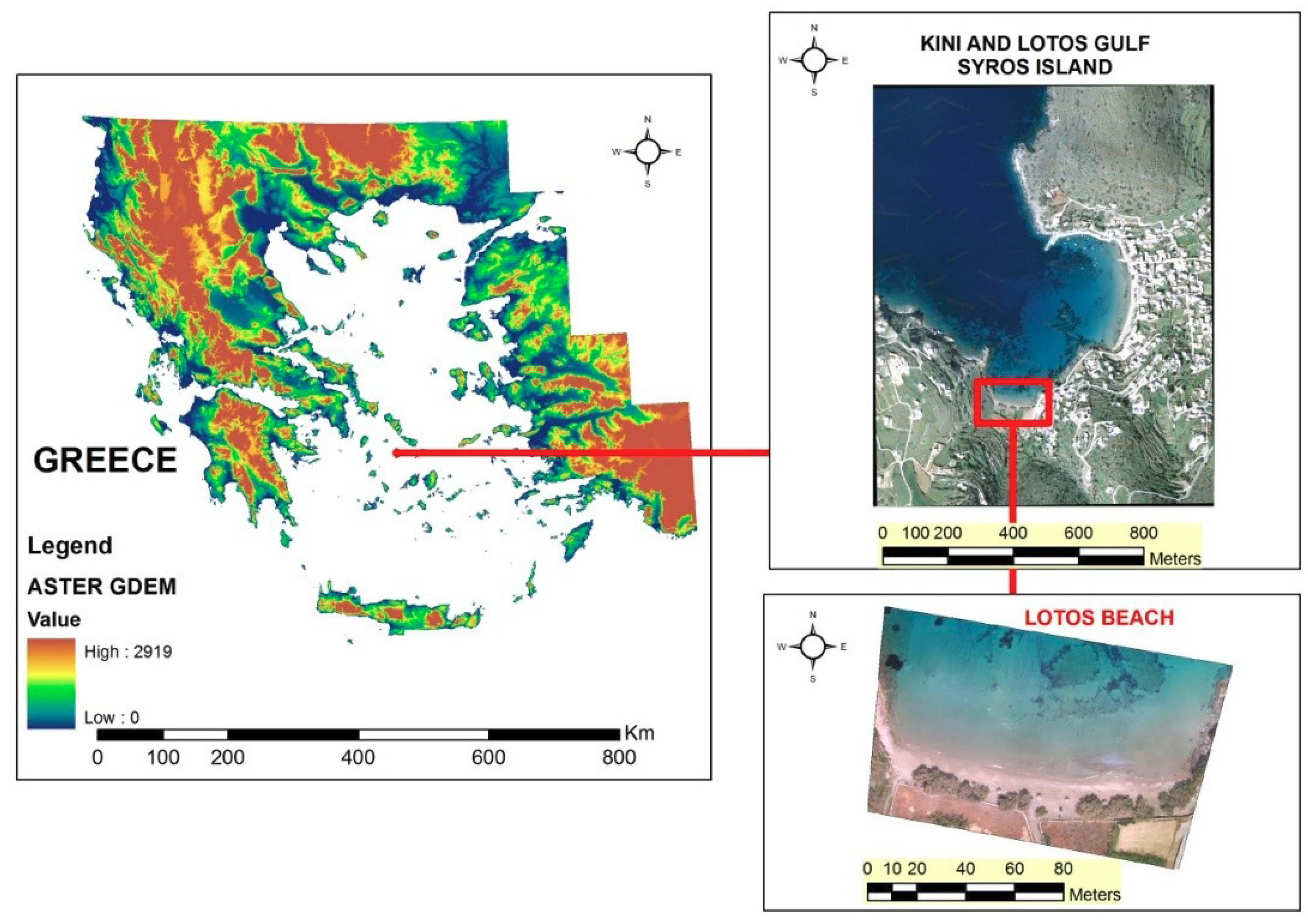
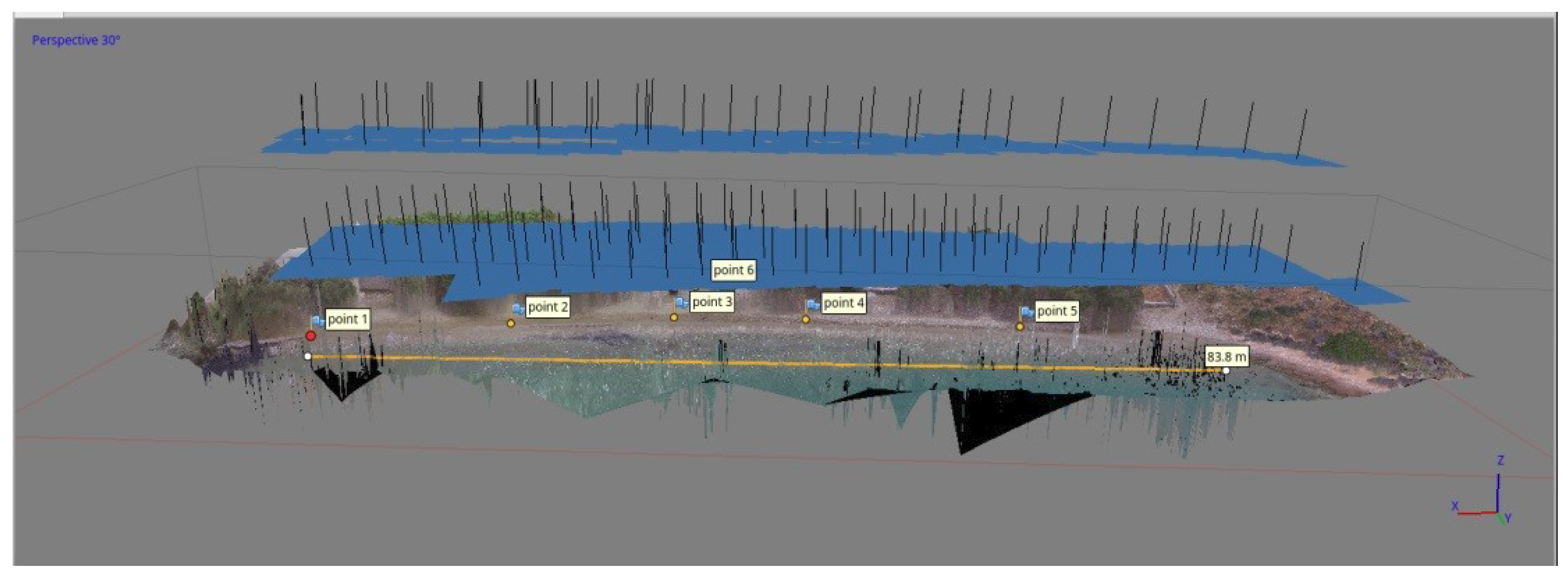
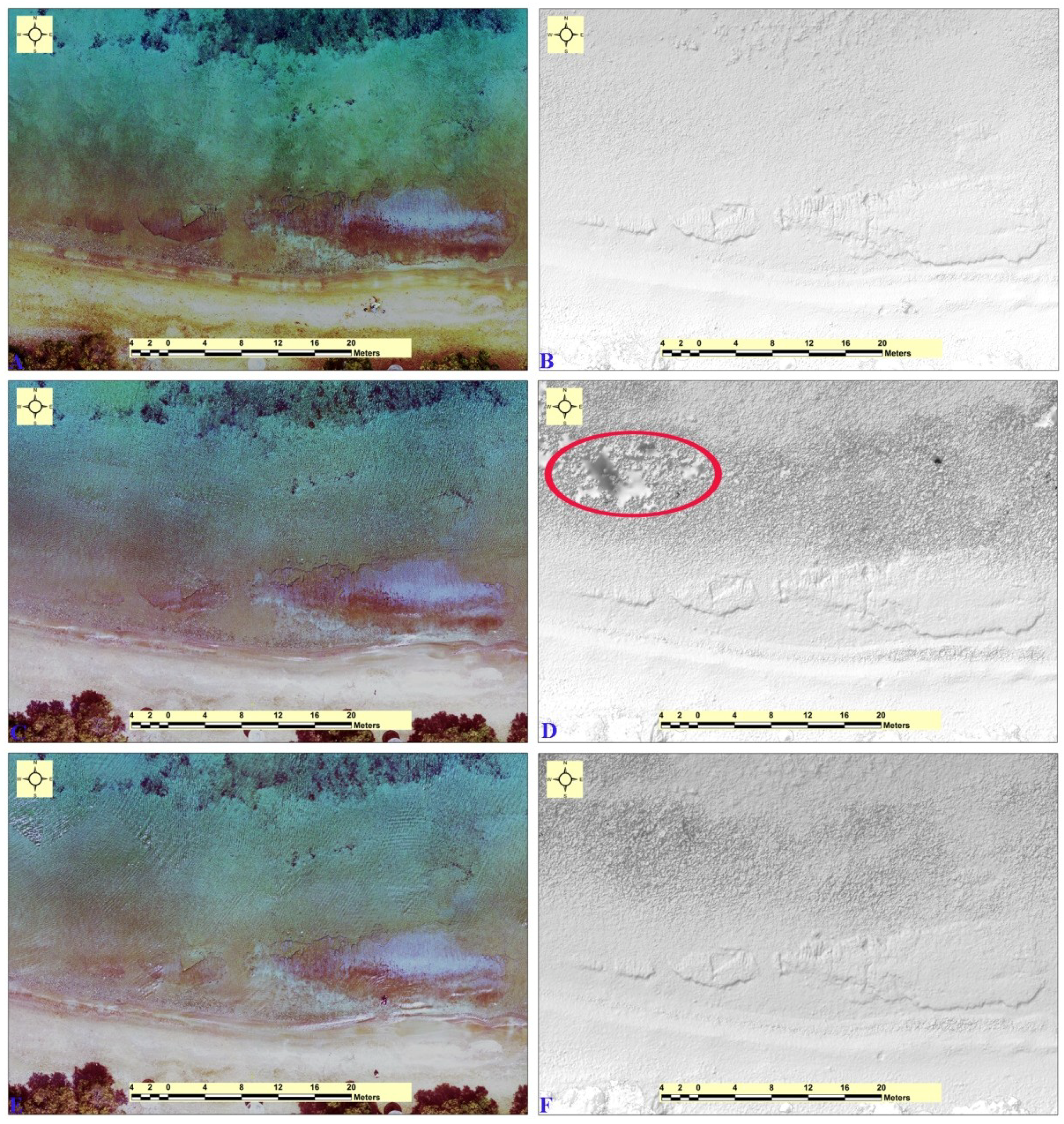
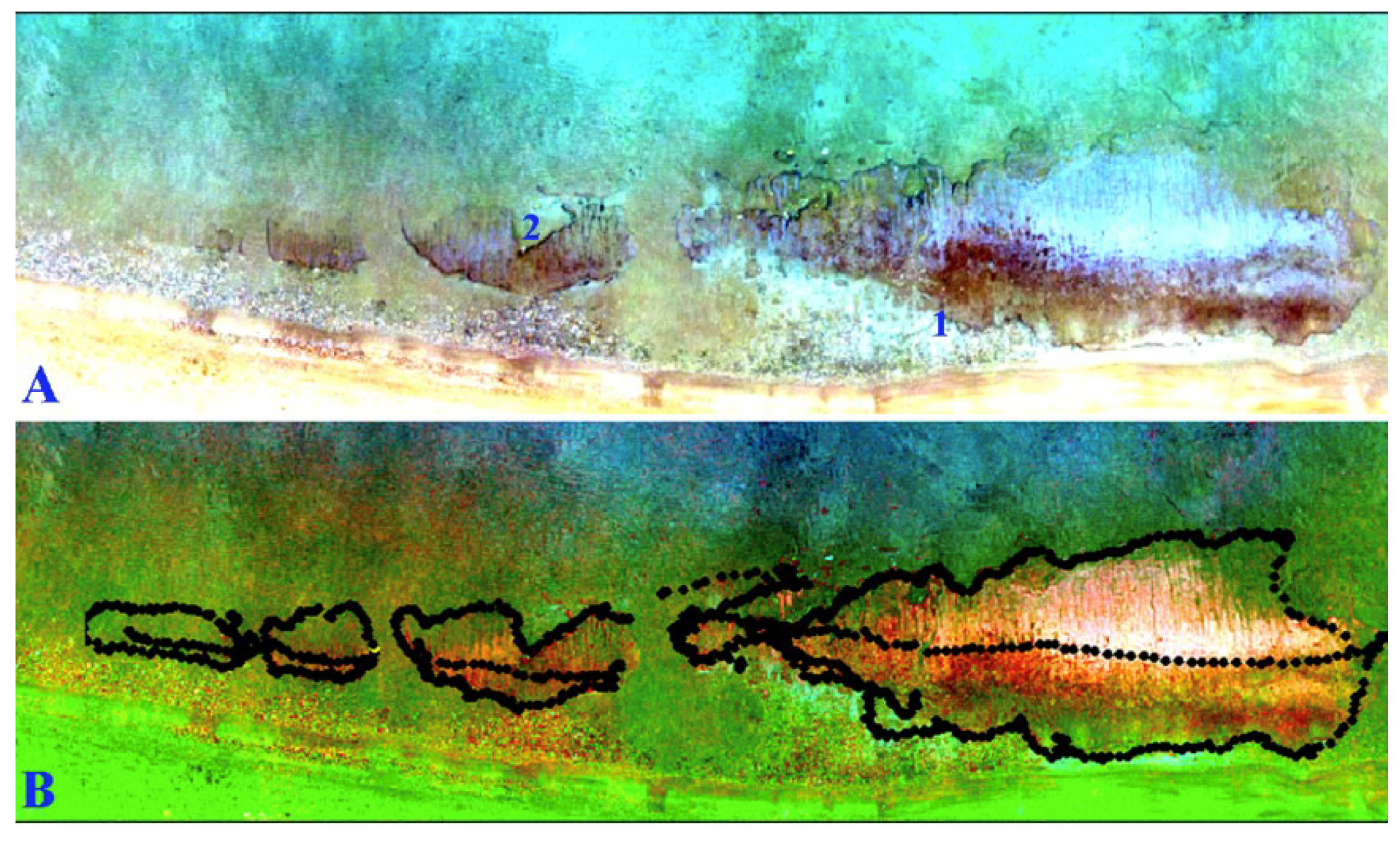
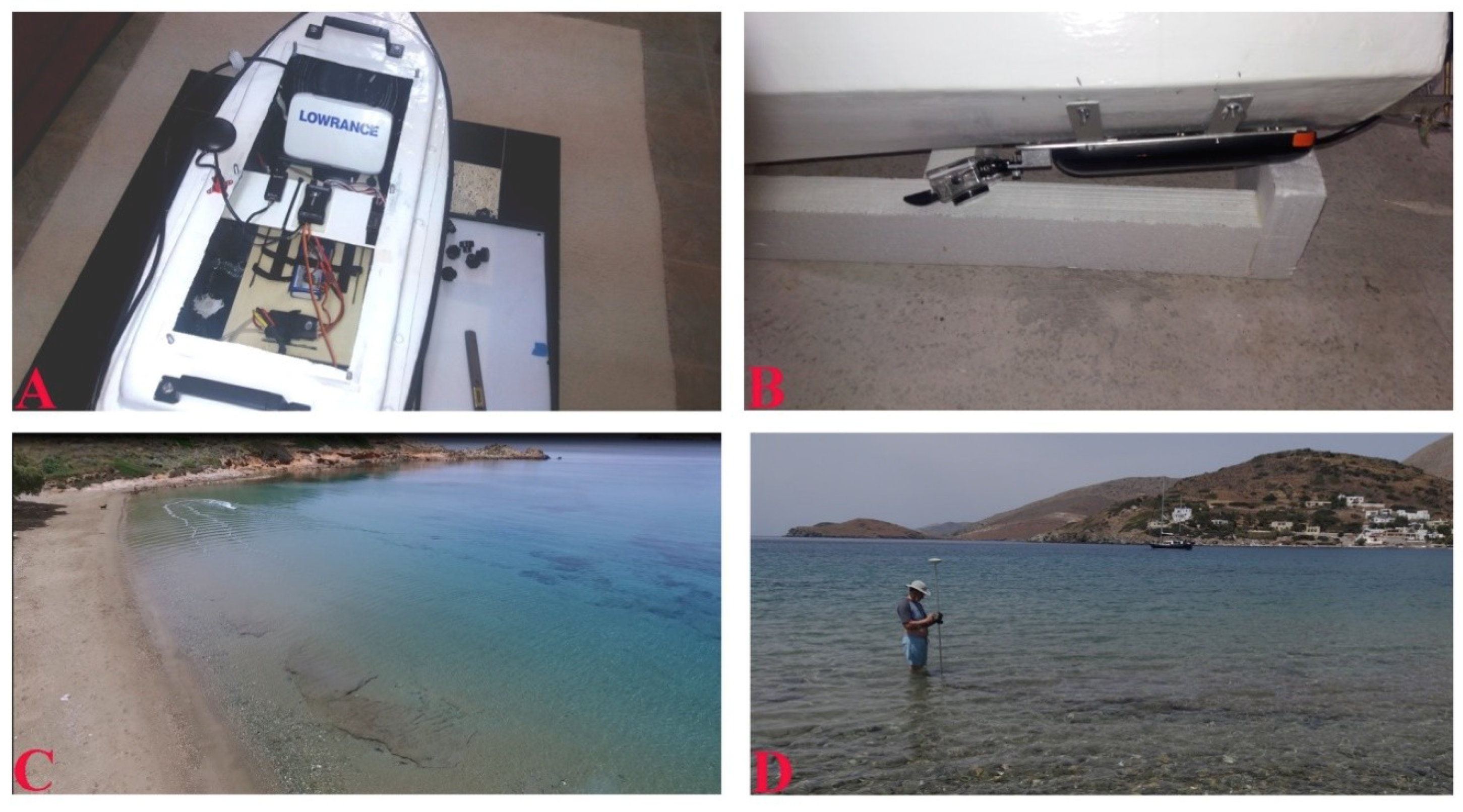
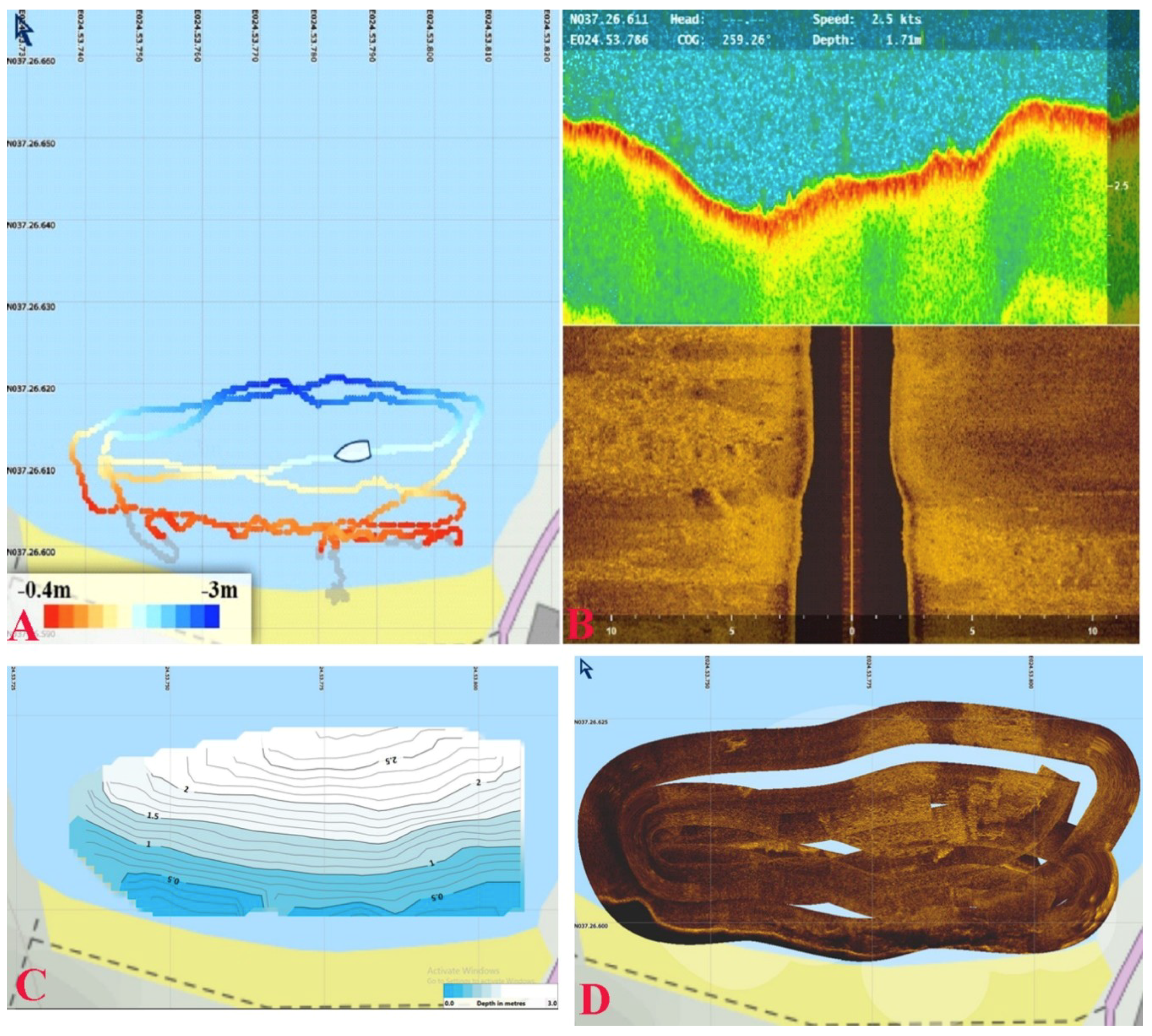
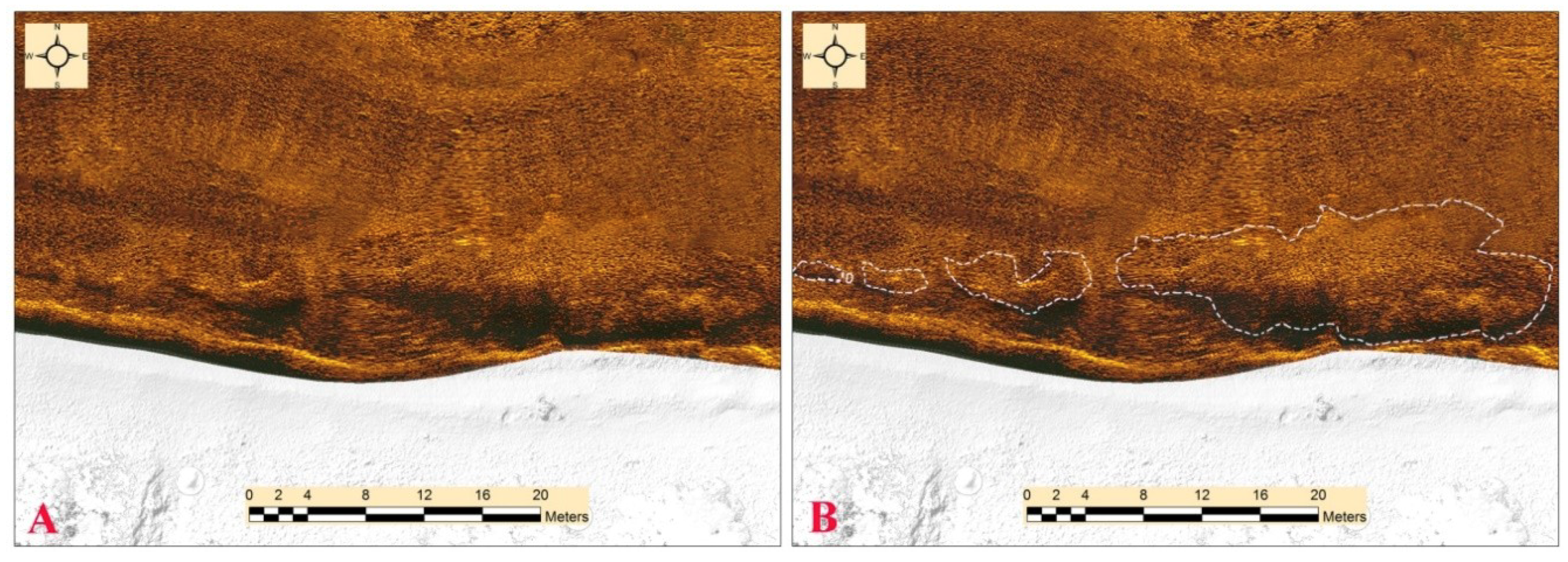



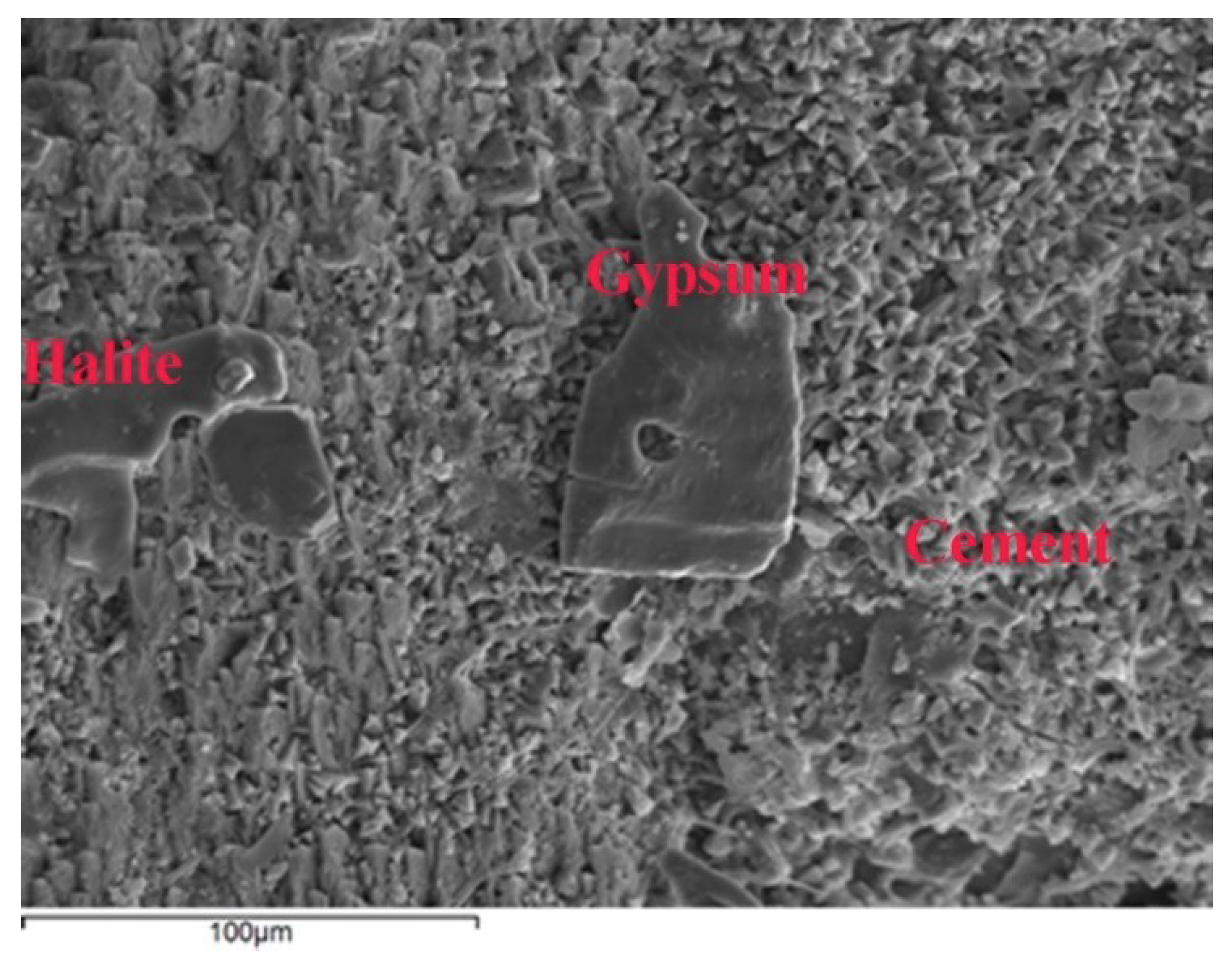
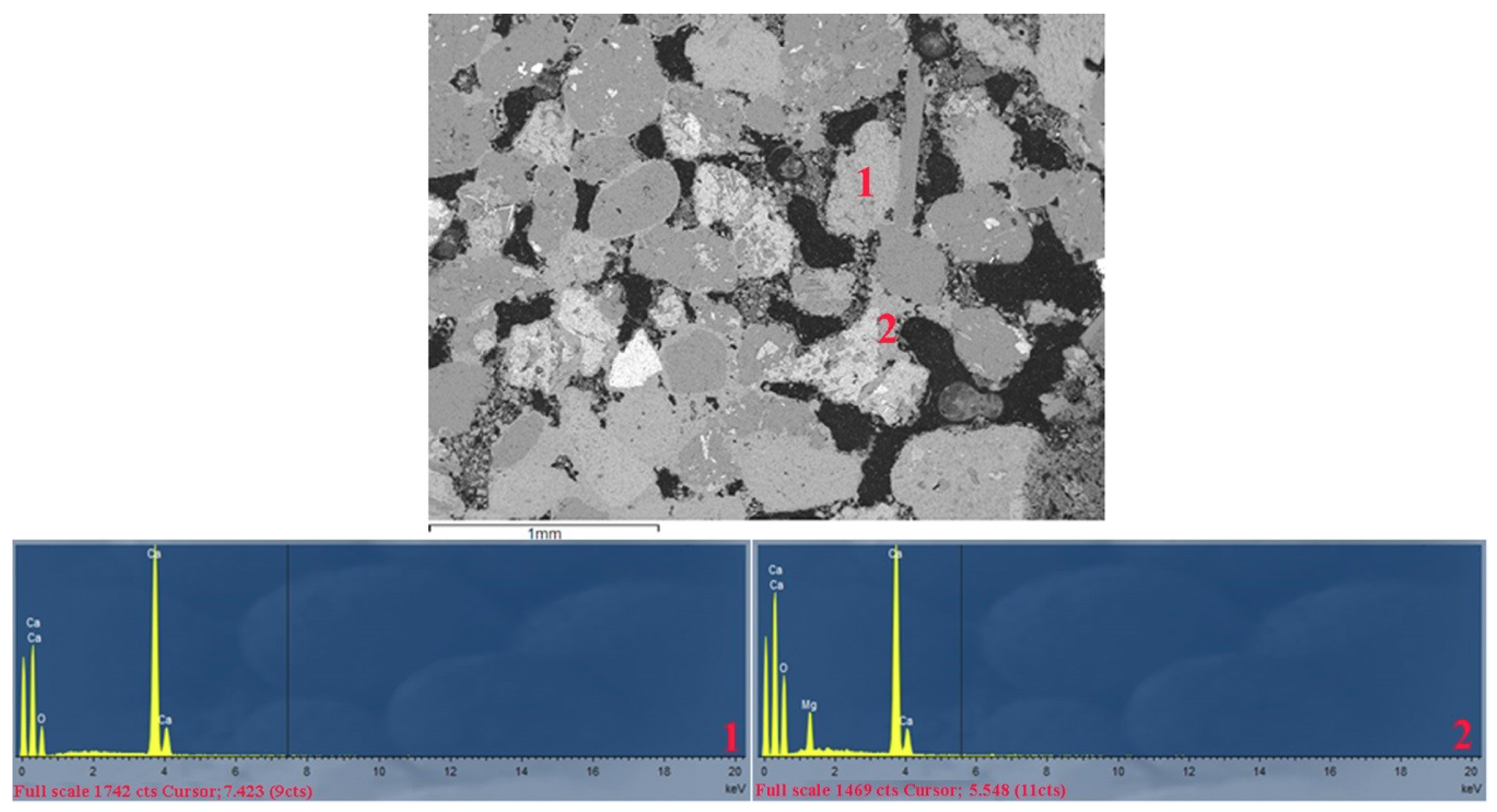
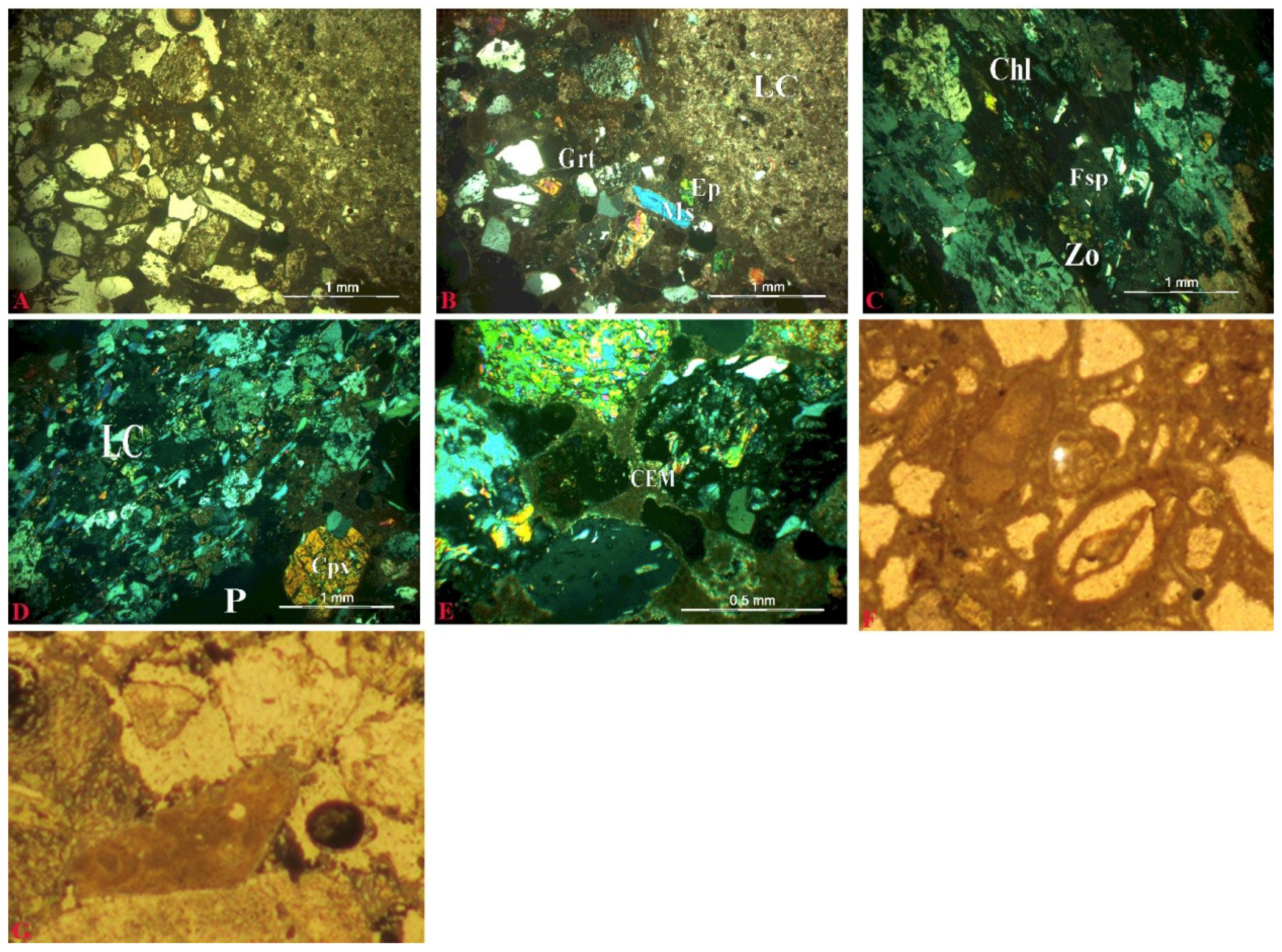
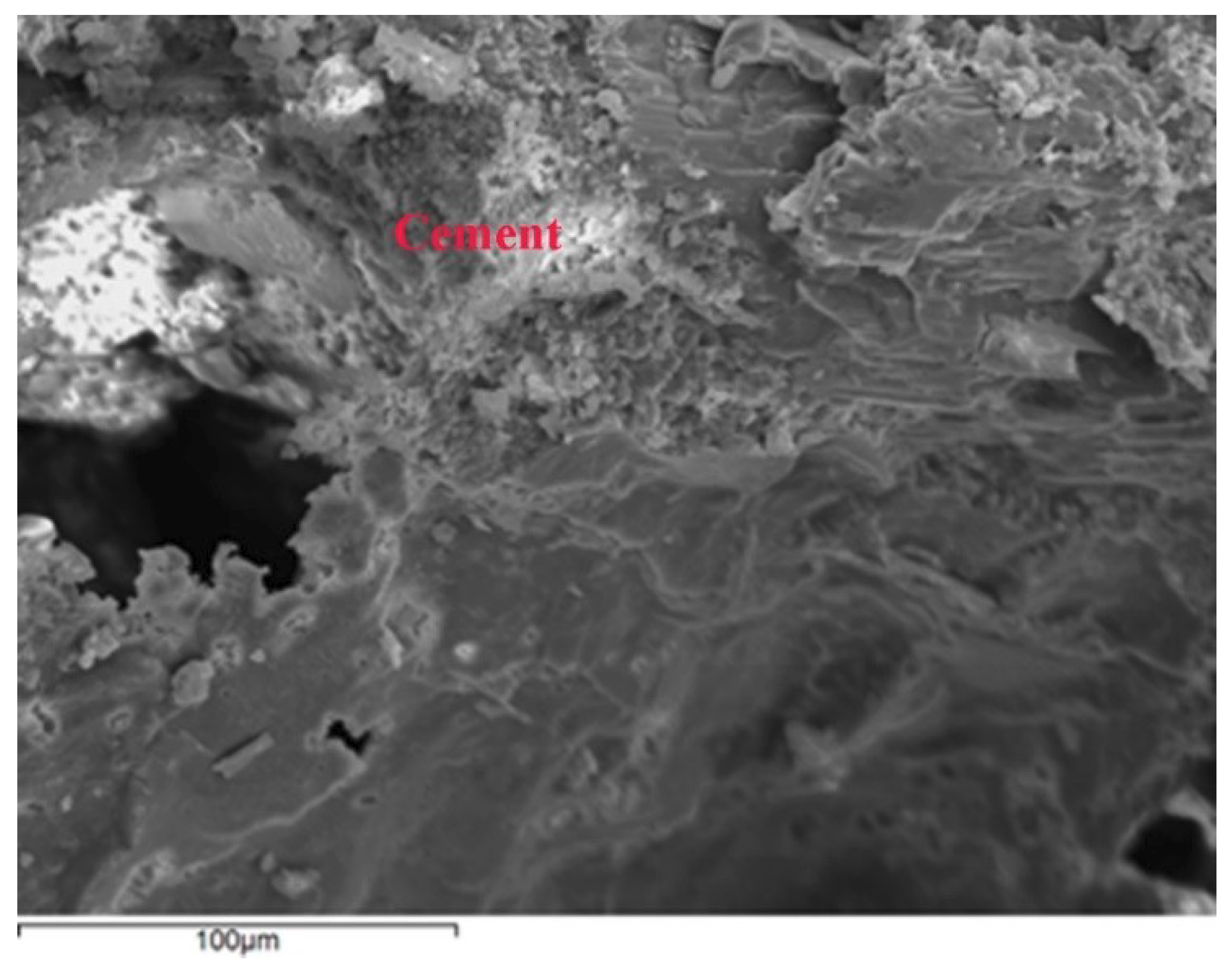
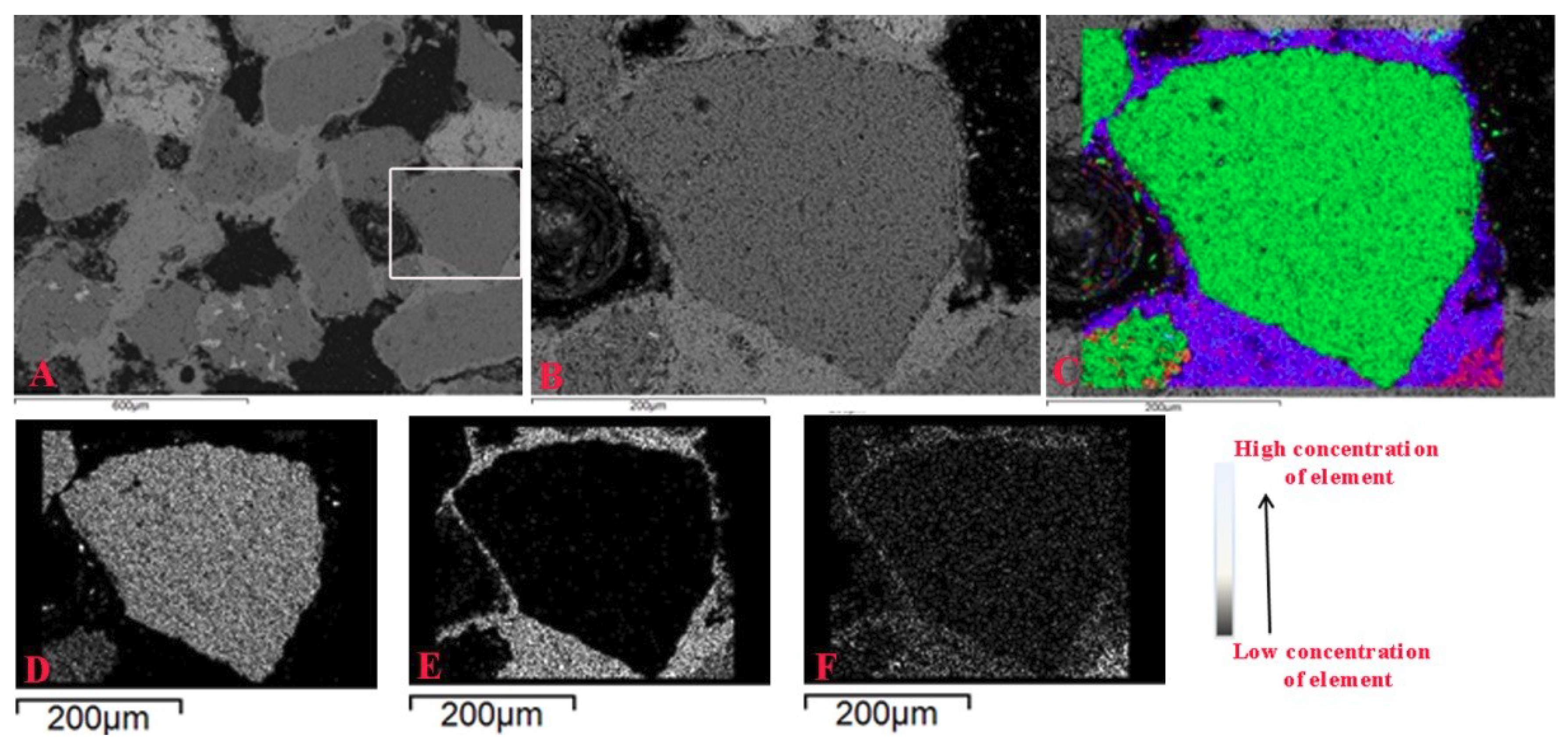
| Flight Campaign Altitude | No of Photos | Orthophoto Spatial Resolution (m) | DSM Spatial Resolution (m) |
|---|---|---|---|
| 20 | 308 | 0.0093 | 0.0186 |
| 25 | 316 | 0.01014 | 0.02028 |
| 30 | 230 | 0.01279 | 0.02558 |
| Flight Campaign Altitude | X Error (cm) | Y Error (cm) | XY Error (cm) | Z Error (cm) | Total Error (cm) |
|---|---|---|---|---|---|
| 20 | 2.07482 | 2.83607 | 3.520082 | 2.245343 | 4.1752298 |
| Sample | Area 1 | Area 2 | ||||
|---|---|---|---|---|---|---|
| Oxide (wt. %) | 1 | 2 | 3 | 1 | 2 | 3 |
| MgO | 1.71 | 4.00 | 6.33 | 1.95 | 6.05 | 8.16 |
| CaO | 53.88 | 51.20 | 49.27 | 53.75 | 49.45 | 47.04 |
| total | 55.60 | 55.20 | 55.60 | 55.70 | 55.50 | 55.20 |
| Number of ions on the base of 3O | ||||||
| Mg | 0.042 | 0.099 | 0.157 | 0.048 | 0.150 | 0.202 |
| Ca | 0.961 | 0.913 | 0.879 | 0.958 | 0.882 | 0.839 |
| * Max mol % MgCO3 in HMC | 16 | 20 | ||||
| * Min mol % MgCO3 in HMC | 4 | 5 | ||||
| * Mean mol % MgCO3 in HMC | 13(±0.6) | 15(±0.6) | ||||
© 2018 by the authors. Licensee MDPI, Basel, Switzerland. This article is an open access article distributed under the terms and conditions of the Creative Commons Attribution (CC BY) license (http://creativecommons.org/licenses/by/4.0/).
Share and Cite
Nikolakopoulos, K.G.; Lampropoulou, P.; Fakiris, E.; Sardelianos, D.; Papatheodorou, G. Synergistic Use of UAV and USV Data and Petrographic Analyses for the Investigation of Beachrock Formations: A Case Study from Syros Island, Aegean Sea, Greece. Minerals 2018, 8, 534. https://doi.org/10.3390/min8110534
Nikolakopoulos KG, Lampropoulou P, Fakiris E, Sardelianos D, Papatheodorou G. Synergistic Use of UAV and USV Data and Petrographic Analyses for the Investigation of Beachrock Formations: A Case Study from Syros Island, Aegean Sea, Greece. Minerals. 2018; 8(11):534. https://doi.org/10.3390/min8110534
Chicago/Turabian StyleNikolakopoulos, Konstantinos G., Paraskevi Lampropoulou, Elias Fakiris, Dimitris Sardelianos, and George Papatheodorou. 2018. "Synergistic Use of UAV and USV Data and Petrographic Analyses for the Investigation of Beachrock Formations: A Case Study from Syros Island, Aegean Sea, Greece" Minerals 8, no. 11: 534. https://doi.org/10.3390/min8110534







